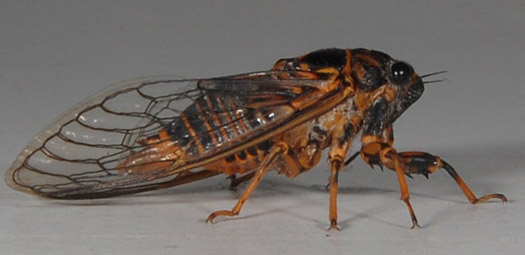More Cicada Survey Work in Concord N.H.
News Category: Cicada General Info
More Cicada Survey Work in Concord N.H.

I returned once again today to try my luck with catching an Okanagana rimosa cicada at the Concord Pine Barrens along Pembroke Rd. I am happy to report that after several failed attempts I was finally successful at snagging one of the little buggers! I managed to catch a singing specimen in a low Aspen tree. The tree was approximately 10 feet tall with a very thin trunk. I was able to grab the trunk and bend it slowly and gently so as not to stress the tree or disturb the cicada. When the cicada was at eye level I grabbed it with my left hand.

More Survey Work at Karner Blue Butterfly Easement
I really like this place but unfortunately, the Okanagana didn't seem to be all that vocal. Since it was around high noon when I arrived here today, I was wondering if they were feeding. During certain parts of the day, cicadas generally get quiet. Very few were calling at that time. I wonder if it is perhaps still too early for the Okanagana to be at peak emergence. I may have to continue my survey work well into late July to see if things change.
Other Insects Photographed at the Karner Blue Butterfly Easement

 The thumbnails to the left and right of this paragraph are of an insect known as Roesel's Katydid Metrioptera roeselii. I have also seen them referred to as Roesel's Bush Cricket. It is unclear to me what categorizes a cricket from a katydid - maybe hind-leg type. They have a very high-pitched trilling call that makes them very difficult to spot and when you get close to them they clam up making them additionally difficult to spot. I recently learned that Metrioptera roeselii was an introduced species that originated in Europe.
The thumbnails to the left and right of this paragraph are of an insect known as Roesel's Katydid Metrioptera roeselii. I have also seen them referred to as Roesel's Bush Cricket. It is unclear to me what categorizes a cricket from a katydid - maybe hind-leg type. They have a very high-pitched trilling call that makes them very difficult to spot and when you get close to them they clam up making them additionally difficult to spot. I recently learned that Metrioptera roeselii was an introduced species that originated in Europe.
Below are several shots of a mating pair of Efferia robber flies. I suspect that these are Efferia aestuans. If you believe that these are a different species please feel free to email me.
The below photos are of a type of milkweed bug. Named such because yes, it feeds on the seeds of Milkweed plants. What's interesting about this insect is that it is in the same order of insects known as Hemiptera which are the same as cicadas. Primarily because insects in this order have wings that are held "roof-like" over the body and have sucking mouth parts known as beaks in which to feed. The antennae also contain 4 to 5 segments. This actually is only a nymph probably in its final instar. The actual species name is Oncopeltus fasciatus. The full grown adults while orange and red like this guy are shaped differently.
More Wildflower Photos
Ok, this is only one plant. I suspected this was Beach Rose but wasn't 100% sure because it is referred to by other names like Wrinkled Rose. Besides, I like them!! Thanks to my friend Lisa's daughter who works at a garden center on Cape Cod for confirming it's id.
Images of Recently Captured Okanagana rimosa
Finally, I'd like to end this article with additional images of this O. rimosa male I captured at the Pembroke road area of the Concord Pine Barrens underneath the power lines.
Date Posted: 2010-06-20 Comments: (0) Show CommentsHide Comments












Comments
Sorry no comments have been posted to this article. Be the first by filling out the form below.